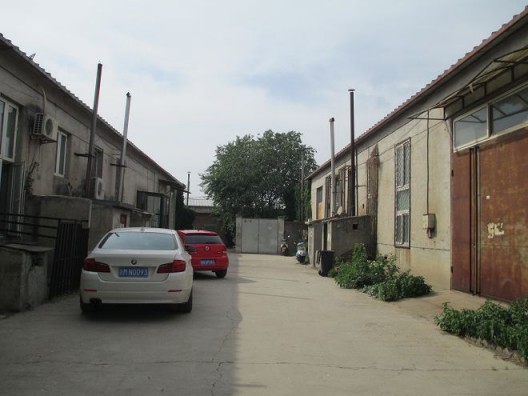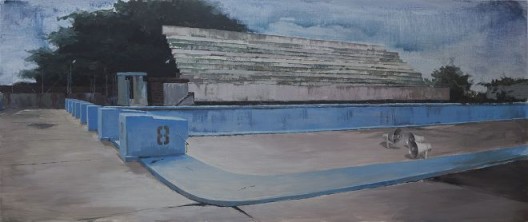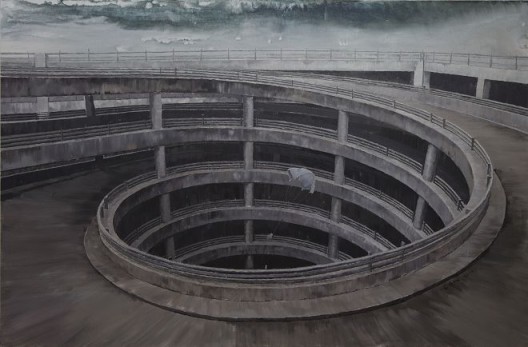Li Yiwen’s studio is located in Heiqiao Village in the southwestern part of Cuigezhuang. Being next to a dump, it leaves much to be desired in terms of sanitation, and on top of the scruffy surroundings, the artist still has to contend with unreasonable landlords and frequent power and water outages. Li Yiwen’s experience is not unique, however; for the majority of recent art school grads, Heiqiao has become the battleground of choice for which to hash out their ideals.
Though not quite as pricey as the increasingly popular Caochangdi and closer than the isolated world of Songzhuan, Heiqiao is only minutes by car from the Fifth Ring road and thus a convenient base for artists working with galleries. Thanks to the artists congregating there, Heiqiao has made a bit of a name for itself as an “art” district, even if there aren’t really any shops or spaces catering to tourists—at most these meager enterprises could be described as artist-initiated experimental spaces. Visitors who aren’t regulars of Heiqiao or those lacking a guide usually have a hard time locating their destination as the approach to street names and numbers is at best abstract and/or non-existent.
With the artist offering directions, I stumbled onto Courtyard No. 1. Aside from the cartoonish sculpture of the God of Fortune, there seemed to be no sign of any art. The compound looked bleak and desolate from the outside, yet inside the 200-sqm factory space, Li Yiwen has created a two-storey dwelling suitable for work and living: a bedroom was located above, while the space below was subdivided into a kitchen, living room and other living spaces. At odds with the minimal style were a few pieces of European furniture in the living room, mostly scrounged from second-hand markets by the artist and his wife. One chair in particular was an antique originally from some church in Italy; the long years of disrepair unfortunately meant that it no longer offered much comfort to the sitter. In contrast to the environment outside the studio, Li Yiwen paints in an orderly area, a space which parallels the order evinced in his work. After a short tour of the space, we sat in front of a tea table designed by Chen Zhiyuan (of the Irrelevant Commission) in the sitting room and chatted about the artist’s recent stylistic changes.


Li Yiwen’s works still had a nostalgic air back in 2012. The sites that appeared in his paintings—school buildings, basketball courts, swimming pools, petrochemical plants—had hues as deep and dark as the aged patina of oil on old machinery. The nostalgia seen in his work seems like either a means by which to alleviate himself from the anxiety of reality, or else a technique of self discovery. And yet the expression of his nostalgia is not a simple longing for a wholesome and beautiful past. Amongst the images of deserted school grounds and courtyards with their suggestion of laughter and play, we see stark gas tanks and loudspeakers—which allude to the repression of individual voices accomplished through a standardized education. In the work “How to Disappear Completely”, for instance, are a deserted stand (for spectators) and an empty swimming pool completely stripped of the usual trappings which accompany such a scene—the cheering crowds and spirited athletes. Yet the loudspeaker left at the bottom of the pool imparts the repressive weight of such collective rituals. The school grounds, factories, and roads create an illogical sensation as if Li Yiwen is seeking to shake off the realist tradition long dominant within academic oil painting in China.

After 2013, the architectural elements in his work ceased to be stand-ins for social issues, but seemed more like visual manifestations of the artist’s spirit, his growing sense of insight, and a certain depth of experience. No longer satisfied with recombinations of images or an ideologically inclined satire, he focused his attention on the properties inherent to painting itself.
This past June, the artist presented his latest works at his solo exhibition at Leo Gallery Hong Kong. Learning and practicing calligraphy and seal engraving from a young age, Li Yiwen is especially sensitive to the weight of the brush and the intensity of ink in calligraphy. In this work, he began to unshackle himself from the figurative and the mimetic using a specially designed paintbrush to decrease his familiarity with the medium and impede the dexterity of his technique, one which he had worked years to master. He sought to resist the orthodox rules of painting with this sense of the unfamiliar along with the accidental expressions brought about in painting. While breaking with set methods of painting, Li Yiwen also started from the standpoint of “forming characters” [jiezi] in calligraphy—the arrangement and placement of the strokes in writing Chinese characters—to reconsider the interrelation between various elements of painting: color, brushwork, and texture. The indecipherable images on the picture plane lead viewers to focus their attention on the juxtaposition of colors, the transformations of textures, the accumulations of paint, the treatment of the space, as seen in his Disordered series of 2015. With an ever-closer framing, the horizontal and vertical structures within the round picture frame no longer offer viewers any clues as to their origins. The objective information is, for the most part, wiped away. Li Yiwen can focus on presenting his reflections on the inter-linkages between the various elements of painting. The colors and brushwork and others here do not change due to phenomena in the real but rather adhere to the logic of painting as created by Li Yiwen himself.
With the construction of a high-speed rail, Heiqiao—an “unofficial” art zone formed spontaneously by artists without one overall company or developer—is facing forced demolition. Li Yiwen has found a new space, around 1,000 sqm next to the new Shunyi branch of the International Exhibition Center, a former warehouse of National Art Museum of China (NAMOC) which he will be sharing with a few of his friends. Though almost ten km further out from the Fifth Ring Road, Li Yiwen said the new location will remove a few degrees of chaos, bringing him a few steps closer to a different kind of contemplation.




